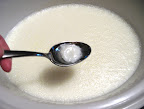
Pictured: yogurt & nectarines. I use Greek yogurt as a healthier substitute for mayo, sour cream, and love it as a snack with a little bit of cinnamon extract and fresh fruit or in a sweet lassi. I've even made cheesecake out of it.
One advantage to homemade yogurt is that you can control the source. Fresh, local, organic milk is easy to find here, but I rarely see local yogurt of the same quality. If you like your yogurt sweetened, you can also control any additives. Making your own can be a money saver, too, especially if you use yogurt as much as we do. A half gallon of milk makes about 5 cups of Greek yogurt. That comes down to about 40 cents a cup for us. A 32 oz. container is about $5 here, so we're spending about 1/3 of that by making a higher quality product ourselves.
You can actually do the entire heat process in a crock pot, but that takes way more time and patience than I'm willing to expend on a weekly basis. I start it on the stove and transfer to a warm crock pot. If you want to do it all in the crock pot, you'll need a little more babysitting to catch it when it's up to temp and then cooled off enough to add the culture. Either way, it's extremely easy. For the combination method outlined below, I just set it all up before going to bed and it's ready for the fridge when I get up in the morning. It can stay in the refrigerator for much of the day until I'm ready to strain it.
Homemade Yogurt (yields approx. 5 cups of Greek yogurt or 7+ cups of unstrained "regular" yogurt)
Ingredients:
- 1/2 gallon milk of your choice (I use skim, but whole and 2% work equally as well, just make sure it's not "ultra pasteurized". Regular pasteurized is fine.)
- 1/2 c. plain yogurt with live cultures (once you've made yogurt for the first time, you can use that for a starter in your next batch)-- you can also get live cultures from any store that sells cheese-making supplies.
- Crock pot (anything larger than 2 quarts) with removable crock
- Candy thermometer or probe thermometer with clip (or instant-read, if using only a crock pot)
- Non-reactive sauce pan or pot larger than 2 quarts
- Large, thick towel or blanket
- Cheesecloth, butter muslin or clean tea towel (for Greek yogurt)
- Large strainer (for Greek yogurt)
2) In a saucepan, heat milk to 185 F (if doing this in a crock pot, this can take a few hours on low), stirring occasionally to ensure the milk isn't burning on the bottom of the pan. What I love about using a probe thermometer, rather than a candy thermometer, is that I have an alarm when it's up to temperature, so I don't have to watch over it very closely.

3) Cool until down to 110 F. You can speed the process by placing the pan in a cool water bath (I use the kitchen sink filled with cold water).
4) Once the milk cools down to 110 F, ladle a cup of milk into a non-reactive bowl (I use glass) with the 1/2 c. yogurt starter and whisk together. Above 110 F can kill the starter, under about 90 F and it won't set.
5) Pour the starter mixture back in with the milk
6) Pour milk into the preheated crock pot
7) Wrap the towel completely around the crock pot to insulate. Turn off the crock pot.

8) Let sit at room temperature for approx. 8 - 10 hours
9) Check consistency with a small, clean spoon. It should be slightly thickened, like soft custard.

10) Don't stir it! Move the covered crock into the refrigerator to thicken completely, approx. 3+ hours. Be careful not to disturb it too much while moving so that the cultures can continue doing their thing. After refrigeration, you should notice some whey pooling on top. This is a sign of further thickening.

11) Store in a glass container, reserving 1/2 c. in a separate container to use as starter for your next batch.
Greek yogurt
To "greekify" your yogurt, you just need to strain it after step 10. Don't forget to set aside 1/2 c. yogurt in a separate container for your next batch. The starter does not need to be strained. A half cup of unstrained yogurt should contain enough active cultures to inoculate a half gallon of milk.
- Ladle the finished yogurt into a strainer lined with fine cheesecloth, butter muslin or a clean tea towel and place over a deep bowl to catch the whey

- Strain in the refrigerator for 2-3 hours until the texture is similar to thick sour cream
- Enjoy!
0 comments:
Post a Comment
Thank you for your comment!